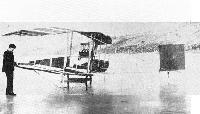
Описание
Страна: США
Год: 1908
Варианты
- Aerial Experimental Association - June Bug / Aerodrome #3 - 1908 - США
- Aerial Experimental Association - Red Wing / White Wing / Aerodrome #1 / #2 - 1908 - США
- Aerial Experimental Association - Silver Dart / Aerodrome #4 - 1909 - США
- Canadian Aerodrome - Baddeck No.1 / No.2 - 1909 - Канада
- P.Bowers Curtiss Aircraft 1907-1947 (Putnam)
- H.King Aeromarine Origins (Putnam)
- A.Andrews. The Flying Machine: Its Evolution through the Ages (Putnam)
-
H.King - Aeromarine Origins /Putnam/
The Aerial Experiment Association's Red Wing, with its ski-runner undercarriage. It was first flown, from the frozen surface of Lake Keuka, on March 12, 1908. The pilot's semi·enclosed nacelle is the crude triangular structure on the left.
-
A.Andrews - The Flying Maschine: Its Evolution through the Ages /Putnam/
Red Wing, first of the American AEA series sponsored by the Aerial Experiment Association, was designed by Lieutenant Thomas E. Selfridge and flew on 12 March 1908, only 6 months before Selfridge died - the first casualty in history as a result of powered flight - when Orville Wright, piloting with Selfridge as passenger, saw his machine break up around him at Fort Myer on 17 September 1908. Red Wing, like its immediate successors, had a 30-40hp Curtiss air-cooled V-8 engine. It is seen fitted with skids for take-off from the ice-bound surface of Lake Keuka, NY. F. W. Baldwin, who took it up for a flight of 319ft, was the first Canadian ever to fly. Like the mayfly, Red Wing had a life of less than a day. When it crash-landed after its second flight, it was abandoned after the engine had been salvaged - an unplanned and undesired obsolescence that was accepted philosophically by the early pioneers.
-
P.Bowers - Curtiss Aircraft 1907-1947 /Putnam/
AEA Aerodrome No.2, While Wing. This was the first aeroplane to have a three-wheeled undercarriage.
P.Bowers Curtiss Aircraft 1907-1947 (Putnam)
Aerodrome No.1, Red Wing The first AEA aeroplane was named Red Wing because of the colour of its fabric covering. It was a biplane with a movable elevator ahead of the wings and a fixed stabilizer behind. A movable rudder was provided, but no means of lateral control. Since it was to be flown from ice, it used skids for an undercarriage. The 'sponsor', or principal designer, was Lt Selfridge.
The first of two flights was made by Thomas Baldwin on 12 March, 1908, since Selfridge was absent on Army business. The flight covered a distance of 318 ft 11 in (97 m) and ended in a crash landing. This has been represented as the first public aeroplane flight in the United States, and figured in the subsequent controversies with the Wrights. The second flight, on 18 March, also ending in a crash, covered only 40 yards and proved the need for lateral control.
Span 43 ft 4 in (13.2 m); wing area 385 sq ft (35.76 sq m); gross weight 570 lb (258 kg); powerplant Curtiss 40 hp air-cooled V-8.
Aerodrome No.2, White Wing The second AEA aeroplane was White Wing, sponsored by Baldwin. It was very similar to Red Wing, except for the substitution of three wheels for the ice runners, and used the same engine. The most important innovation was the addition of movable lateral control surfaces on all four wingtips that later came to be called ailerons. In principle, these had the same effect as the Wright's wing-warping, but Curtiss claimed mechanical and control differences. The method of control reflected Curtiss's motorcyle experience - a yoke embraced the pilot's shoulders - when he wanted to bank for a turn, he leaned in the desired direction and the proper control movement was automatically applied.
White Wing made four flights, the first on 18 May, 1908, again with Baldwin at the controls. Distance was 93 yards (85 m) at a height of 10 ft (3 m). Longest flight was the third, at 339 yards (310m) with Curtiss flying. While Wing crashed on 23 May after McCurdy had flown 183 yards (167 m).
Span 42 ft 3 in (12.87 m); wing area 408 sq ft (37.9 sq m); gross weight 605 lb (274 kg).
Описание:



